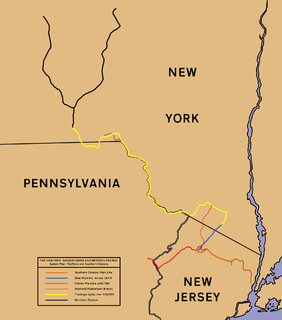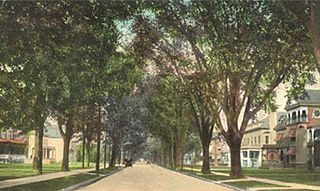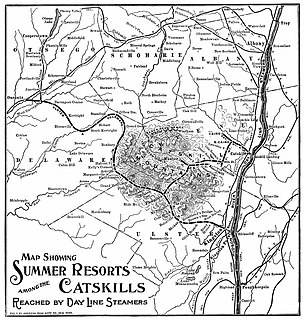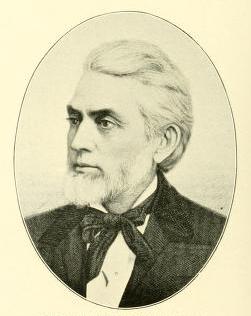Related Research Articles

Geddes is a town in Onondaga County, New York, United States. The population was 17,118 at the 2010 census.

The New York Central Railroad was a railroad primarily operating in the Great Lakes and Mid-Atlantic regions of the United States. The railroad primarily connected greater New York and Boston in the east with Chicago and St. Louis in the Midwest, along with the intermediate cities of Albany, Buffalo, Cleveland, Cincinnati, Detroit, and Syracuse. New York Central was headquartered in New York City's New York Central Building, adjacent to its largest station, Grand Central Terminal.

The New York, Susquehanna and Western Railway is a Class II American freight railway operating over 400 miles (645 km) of track in the northeastern U.S. states of New York, Pennsylvania, and New Jersey.

The Near Westside is one of the oldest neighborhoods of Syracuse, New York, United States. In the early 1900s, many wealthy families, including the Mayor of Syracuse, lived in large homes along West Onondaga Street. A beautiful fountain with statues was located at Onondaga Circle, the junction of West Onondaga Street and Delaware Street. Streets like Delaware Street were lined with large elm trees and stately homes.
The Syracuse Far Westside is one of 26 neighborhoods recognized by the City of Syracuse, New York. Until this area joined the city in 1886 it was known as the Village of Geddes.

The IRT Ninth Avenue Line, often called the Ninth Avenue Elevated or Ninth Avenue El, was the first elevated railway in New York City. It opened on July 3, 1868 as the West Side and Yonkers Patent Railway, as an experimental single-track cable-powered elevated railway from Battery Place, at the south end of Manhattan Island, northward up Greenwich Street to Cortlandt Street. It ceased operation on June 11, 1940, after it was replaced by the IND Eighth Avenue Line which had opened in 1932.
The Oswego and Syracuse Railroad was formed April 29, 1839, and the route was surveyed during the summer of that year. The Company was fully organized March 25, 1847. The road was opened on May 14, 1848, and ran a total distance of 35.5 miles (57.1 km) from Syracuse, New York to Oswego, New York. In 1872 it passed under the management of the Delaware, Lackawanna and Western Railroad.

The Ulster and Delaware Railroad (U&D) was a railroad located in the state of New York. It was often advertised as "The Only All-Rail Route to the Catskill Mountains." At its greatest extent, the U&D extended 107 miles from Kingston Point on the Hudson River through the Catskill Mountains to its western terminus at Oneonta, passing through the counties of Ulster, Delaware, Schoharie and Otsego.
The Syracuse, Ontario and New York Railway was founded in 1883 and had a line that ran between Syracuse, New York and Earlville, New York, a distance of 45.5 miles (73.2 km). The company formed from the Syracuse, Chenango and New York Railroad Company. Beginning on July 1, 1890 it operated as the Chenango County, New York branch of the West Shore Railroad. On April 2, 1891, the railroad and property of the Syracuse Ontario and New York Railway Company were formally leased, for the term of its corporate existence, to the West Shore Railroad Company on June 30, 1891. Later, ownership was transferred to the New York Central Railroad (NYCRR).
The Auburn and Syracuse Railroad was incorporated on May 1, 1834, to provide easy access between Syracuse, New York, and the Erie Canal. Construction was begun in 1835, but was delayed during the Panic of 1837. Although the economic downturn lingered until 1843, the railroad was completed by January 1838.

New York State Railways was a subsidiary of the New York Central Railroad that controlled several large city streetcar and electric interurban systems in upstate New York. It included the city transit lines in Rochester, Syracuse, Utica, Oneida and Rome, plus various interurban lines connecting those cities. New York State Railways also held a 50% interest in the Schenectady Railway Company, but it remained a separate independent operation. The New York Central took control of the Rochester Railway Company, the Rochester and Eastern Rapid Railway and the Rochester and Sodus Bay Railway in 1905, and the Mohawk Valley Company was formed by the railroad to manage these new acquisitions. New York State Railways was formed in 1909 when the properties controlled by the Mohawk Valley Company were merged. In 1912 it added the Rochester and Suburban Railway, the Syracuse Rapid Transit Railway, the Oneida Railway, and the Utica and Mohawk Valley Railway. The New York Central Railroad was interested in acquiring these lines in an effort to control the competition and to gain control of the lucrative electric utility companies that were behind many of these streetcar and interurban railways. Ridership across the system dropped through the 1920s as operating costs continued to rise, coupled with competition from better highways and private automobile use. New York Central sold New York State Railways in 1928 to a consortium led by investor E. L. Phillips, who was looking to gain control of the upstate utilities. Phillips sold his stake to Associated Gas & Electric in 1929, and the new owners allowed the railway bonds to default. New York State Railways entered receivership on December 30, 1929. The company emerged from receivership in 1934, and local operations were sold off to new private operators between 1938 and 1948.
The South Side Railroad of Long Island was a railroad company in the U.S. state of New York. Chartered in 1860 and first opened in 1867 as a competitor to the Long Island Rail Road, it was reorganized in 1874 as the Southern Railroad of Long Island and leased in 1876 to the LIRR. After a reorganization as the Brooklyn and Montauk Railroad in 1879 it was merged in 1889.
The Railroad industry in Syracuse, New York got its start in October 1831 when a convention held in the city marked one of the earliest moves to stimulate the era of railroad building which ultimately brought steam railroad service to New York State.
The Syracuse and Binghamton Railroad was established on August 18, 1851, and opened for business on October 18, 1854. The road merged in 1856 into Syracuse and Southern Railroad which was renamed to Syracuse, Binghamton and New York Railroad when the company reorganized after foreclosure in 1857.
The Syracuse Northern Railroad, incorporated in 1868 and opened on November 9, 1871, drew trade from Liverpool to Syracuse, New York. The line had routes to Watertown, New York, and in 1875, the road was extended to Pulaski and Lacona.
The Syracuse Consolidated Street Railway, chartered on May 22, 1890, in Syracuse, New York. On July 1, 1890, the company leased, in perpetuity, several street railroads in the city including Third Ward Railway, Fourth Ward Railroad, Fifth Ward Railroad, Seventh Ward Railroad, Eleventh Ward Railroad, Genesee and Water Street Railroad, Woodlawn and Butternut Street Railway, Syracuse and Geddes Railway and New Brighton and Onondaga Valley Railroad. The rail ran a total distance of 24 miles (39 km) and had branches every 3 miles (4.8 km).
The Central City Railway was chartered on April 19, 1859, and was the first street railway company in Syracuse, New York. It began operations in August 1860, as a horse-drawn rail. The road was discussed for many years before it was actually constructed as a link between the First Ward and Erie Canal at Salina Street. The train line commenced at South Salina Street opposite the Syracuse House and terminated in the First Ward.
The Syracuse and Geddes Railway, a horse-drawn street trolley in Syracuse, New York, was chartered on July 10, 1863. The line ran from Syracuse to Geddes, a suburb. The route ran from Salina Street and Fayette Street to Hemlock, Bridge and Furnace Street.
The Syracuse and Onondaga Railway, a horse-drawn city railway, was chartered on April 29, 1863, and opened on July 25, 1864, in Syracuse, New York. The line commenced in Downtown Syracuse at Washington Street and terminated at Oakwood Cemetery at Brighton Avenue where it connected with the Onondaga Valley Railroad. By 1890, the total length of the road was 2 miles (3.2 km).

Daniel Phelps Wood was an American lawyer and politician from New York.
References
- ↑ "First Streetcars Operated Here in 1860". Syracuse Herald . Syracuse, New York. December 14, 1922.
- ↑ Laws of the State of New York, Volume 1. New York State, 1868 p. 262. 1868. Retrieved July 5, 2011.
- 1 2 Bruce, Dwight Hall. Memorial history of Syracuse, N.Y., from its settlement to the present time. Electronic Library, 2011. Retrieved July 5, 2011.
- ↑ Boyd's Syracuse Boyd's City Directory 1875. Andrew Boyd, 1875.